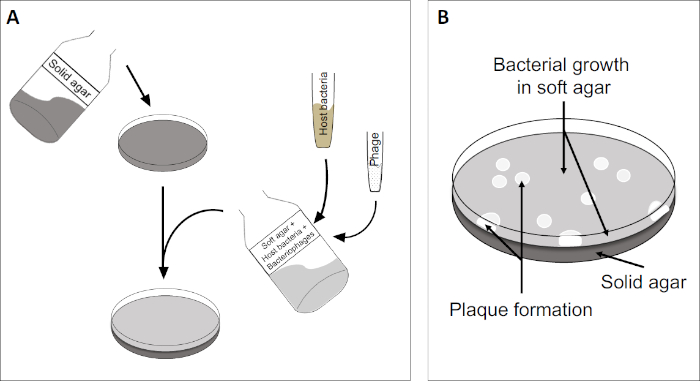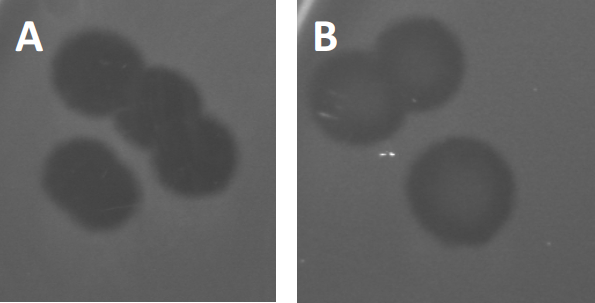Ensaio de placa: um método para determinar o título viral como unidades formadoras de placa (PFU)
Visão Geral
Fonte: Tilde Andersson1, Rolf Lood1
1 Departamento de Ciências Clínicas Lund, Divisão de Medicina de Infecção, Centro Biomédico, Universidade de Lund, 221 00 Lund, Suécia
Vírus que infectam organismos procarióticos, chamados bacteriófagos ou simplesmente fálticos, foram identificados no início do séculoXX por Twort (1) e d'Hérelle (2) de forma independente. Desde então, os phages têm sido amplamente reconhecidos por seu valor terapêutico (3) e sua influência sobre os humanos (4), bem como os ecossistemas globais (5). As preocupações atuais têm alimentado um interesse renovado no uso de phages como alternativa aos antibióticos modernos no tratamento de doenças infecciosas (6). Essencialmente, todas as pesquisas de phage dependem da capacidade de purificar e quantificar vírus, também conhecido como um titer viral. Inicialmente descrito em 1952, este era o propósito do ensaio da placa (7). Décadas e múltiplos avanços tecnológicos depois, o ensaio da placa continua sendo um dos métodos mais confiáveis para a determinação do título viral (8).
Bacteriophages subsistem injetando seu material genético em células hospedeiras, sequestrando as máquinas para produção de novas partículas de phage, e eventualmente fazendo com que o hospedeiro libere numerosos virions progêneres através da lise celular. Devido ao seu tamanho minucioso, os bacteriófagos não podem ser observados usando apenas microscopia leve; portanto, é necessária a microscopia eletrônica de varredura (Figura 1). Além disso, os phages não podem ser cultivados em placas de ágar nutricional como bactérias, pois precisam de células hospedeiras para se aproveitarem.

Figura 1: A morfologia de um bacteriófago, aqui exemplificado por um phage E. coli, pode ser estudado usando microscopia eletrônica de varredura. A maioria dos bacteriófagos pertence a Caudovirales (bacteriófagos tailed). Este phage em particular tem uma estrutura de cauda muito curta e uma cabeça icosaedral, colocando-a na família de Podovírus.
O ensaio da placa (Figura 2) baseia-se na incorporação de células hospedeiras, preferencialmente em crescimento de fase de registro, no meio. Isso cria uma densa camada turva de bactérias capazes de sustentar o crescimento viral. Uma praga isolada pode infectar, replicar dentro e lise uma célula. A cada célula lise, várias células adjacentes ficam imediatamente infectadas. Vários ciclos dentro, uma zona clara (uma placa) pode ser observada na placa turva (Figura 2B/Figura 3A), indicando a presença do que inicialmente era uma única partícula bacteriófago. O número de unidades formadoras de placas por volume (ou seja, PFU/mL) de uma amostra, pode ser determinado a partir do número de placas geradas.

Figura 2: O teste para unidades de formação de placas (PFU) é um método comum para determinar o número de bacteriófagos em uma amostra. (A) A base de uma placa de Petri estéril é coberta com um meio de nutrientes sólidos apropriado, seguido por uma mistura de mídia macia, células hospedeiras suscetíveis e uma diluição da amostra original de bacteriófago. Note que a suspensão de phage poderia, em alguns casos, também ser uniformemente espalhada pela superfície de ágar macio já solidificado. (B) O crescimento das bactérias hospedeiras forma um gramado de células na camada superior do ágar. A replicação do bacteriófago gera zonas claras, ou placas, causadas pela lise celular hospedeira.

Figura 3: Os resultados do teste de PFU mostram múltiplas placas geradas por bacteriófagos. Devido à lise de células hospedeiras suscetíveis, as placas podem ser vistas como zonas de compensação no gramado bacteriano, seja com (A) desobstrução total, ou (B) re-crescimento parcial causado pela geração de bactérias resistentes (ou possivelmente por phages temperados no ciclo lisogênico).
Certos fáticos temperados podem adotar o que é chamado de ciclo de vida lisogênico, além do crescimento lítico descrito anteriormente. Na lysogenia, o vírus assume um estado latente através da incorporação de seu material genético no genoma da célula hospedeira (9), muitas vezes conferindo resistência a novas infecções por pragas. Isso às vezes é revelado através de uma leve nebulosidade da placa (Figura 3B). Vale ressaltar, porém, que as placas também podem aparecer borradas devido ao reesúde de bactérias que evoluíram resistência ao phage independente de infecções anteriores.
Os vírus podem se conectar, ou adsorb, a apenas uma gama limitada de bactérias hospedeiras (10). As faixas de host são ainda limitadas por estratégias antivirais intracelulares, como o sistema CRISPR-Cas (11). A resistência/sensibilidade para phages específicos exibidos por subgrupos bacterianos tem sido historicamente usada para categorizar cepas bacterianas em diferentes tipos de phage (Figura 4). Embora a eficácia deste método tenha sido agora superada por novas técnicas de sequenciamento, a digitação de phage ainda pode fornecer informações valiosas sobre interações bactérias-phage, por exemplo, facilitando o design de um coquetel phage para uso clínico.

Figura 4: Sensibilidade à praga de diferentes cepas bacterianas. Placas de ágar macio com cepa cutibacterium acnes (A) AD27 e (B) AD35, foram avistadas com 21 bacteriófagos C. acnes diferentes. Apenas o phage 11 foi capaz de infectar e matar AD27, enquanto a cepa AD35 mostrou sensibilidade para todas as pragas. Esta técnica, denominada digitação phage, pode ser usada para dividir espécies bacterianas e cepas em diferentes subgrupos com base na suscetibilidade de phage.
Procedimento
1. Configuração
- Antes de iniciar qualquer trabalho envolvendo micróbios, certifique-se de que o espaço de trabalho seja esterilizado (por exemplo, limpo com 70% de etanol). Use sempre um jaleco e luvas, mantenha os cabelos longos amarrados para trás e certifique-se de que todas as feridas estejam particularmente bem protegidas.
- Quando terminar, esterilize todas as superfícies e lave/esterilize completamente as mãos e pulsos.
2. Protocol
Aplicação e Resumo
Apesar dos múltiplos avanços tecnológicos, os ensaios de placas continuam sendo o padrão-ouro para a determinação do título viral (como PFU) e essencial para o isolamento de populações de bacteriófagos puros. Células hospedeiras suscetíveis são cultivadas na camada superior de uma placa de ágar de duas camadas, formando uma cama homogênea que permite a replicação viral. O evento inicial em que um bacteriófago isolado no ciclo de vida lítico infecta uma célula, se replica dentro dela e, eventualmente, ...
Referências
- Twort, F. An investigation on the nature of ultra-microscopic viruses. Lancet. 186 (4814): 1241-1243. (1915)
- d'Hérelle, F. An invisible antagonist microbe of dysentery bacillus. Comptes Rendus Hebdomadaires Des Seances De L Academie Des Sciences. 165: 373-375. (1917)
- Cisek AA, Dąbrowska I, Gregorczyk KP, Wyżewski Z. Phage Therapy in Bacterial Infections Treatment: One Hundred Years After the Discovery of Bacteriophages. Current Microbiology. 74 (2):277-283. (2017)
- Mirzaei MK, Maurice CF. Ménage à trois in the human gut: interactions between host, bacteria and phages. Nature Reviews Microbiology. 15 (7):397. (2017)
- Breitbart M, Bonnain C, Malki K, Sawaya NA. Phage puppet masters of the marine microbial realm. Nature Microbiology. 3 (7):754-766. (2018)
- Leung CY, Weitz JS. Modeling the synergistic elimination of bacteria by phage and the innate immune system. Journal of Theoretical Biology. 429:241-252. (2017)
- Dulbecco R. Production of Plaques in Monolayer Tissue Cultures by Single Particles of an Animal Virus. Proceedings of the National Academy of Sciences of the United States of America. 38 (8):747-752. (1952)
- Juarez D, Long KC, Aguilar P, Kochel TJ, Halsey ES. Assessment of plaque assay methods for alphaviruses. J Virol Methods. 187 (1):185-9. (2013)
- Clokie MRJ, Millard AD, Letarov AV, Heaphy S. 2011. Phages in nature. Bacteriophage. 1 (1):31-45. (2011)
- Moldovan R, Chapman-McQuiston E, Wu XL. On kinetics of phage adsorption. Biophys J. 93 (1):303-15. (2007)
- Garneau JE, Dupuis M-È, Villion M, Romero DA, Barrangou R, Boyaval P, Fremaux C, Horvath P, Magadán AH, Moineau S.. The CRISPR/Cas bacterial immune system cleaves bacteriophage and plasmid DNA. Nature. 468 (7320):67. (2010)
Pular para...
Vídeos desta coleção:

Now Playing
Ensaio de placa: um método para determinar o título viral como unidades formadoras de placa (PFU)
Microbiology
186.2K Visualizações

Criando uma coluna de Winogradsky: um método para enriquecer as espécies microbianas em uma amostra de sedimento
Microbiology
129.4K Visualizações

Diluições em série e plaqueamento: enumeração microbiana
Microbiology
316.2K Visualizações

Culturas de enriquecimento: cultivo de micróbios aeróbicos e anaeróbicos em meios seletivos e diferenciais
Microbiology
132.1K Visualizações

Culturas puras e semeadura por esgotamento: isolamento de colônias bacterianas únicas de uma amostra mista
Microbiology
166.2K Visualizações

Sequenciamento de rRNA 16S: uma técnica baseada em PCR para identificar espécies bacterianas
Microbiology
189.0K Visualizações

Curvas de crescimento: gerando curvas de crescimento usando unidades formadoras de colônias e medições de densidade óptica
Microbiology
296.1K Visualizações

Teste de sucetibilidade a antibióticos: testes de epsilômetro para determinar valores de MIC de dois antibióticos e avaliar a sinergia de antibióticos
Microbiology
93.8K Visualizações

Microscopia e Coloração: Coloração de Gram, Cápsula e Endósporo
Microbiology
363.4K Visualizações

Transformação de células de E. coli usando um protocolo adaptado de cloreto de cálcio
Microbiology
86.8K Visualizações

Conjugação: um método para transferir a resistência à ampicilina da E. coli doadora para a receptora
Microbiology
38.2K Visualizações

Transdução fágica: um método para transferir a resistência à ampicilina da E. coli doadora para a receptora
Microbiology
29.1K Visualizações
Copyright © 2025 MyJoVE Corporation. Todos os direitos reservados
 (ie)
(ie)